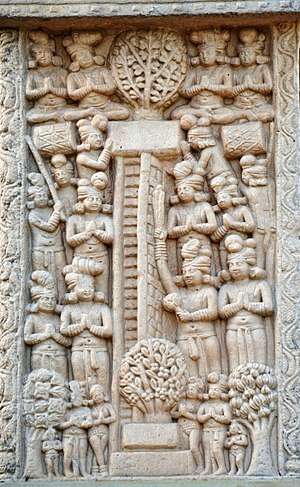Trāyastriṃśa
| Translations of Trāyastriṃśa | |
|---|---|
| Pali | Tāvatiṃsa |
| Sanskrit | Trāyastriṃśa |
| Burmese |
တာဝတိံသာ (IPA: [tàwədèɪɴðà]) |
| Chinese |
忉利天 (Pinyin: =Dāolì tiān) |
| Japanese |
忉利天 (rōmaji: Tōriten) |
| Khmer |
ត្រ័យត្រិង្ស , តាវត្តិង្ស (Trai troeng, Tavotoeng) |
| Korean |
도리천 (RR: Doricheon) |
| Thai |
ดาวดึงส์ (RTGS: Daowadueng) |
| Glossary of Buddhism | |
The Trāyastriṃśa (Sanskrit; Pali Tāvatiṃsa) heaven is an important world of the devas in Hindu and Buddhist cosmology. The word trāyastriṃśa is an adjective formed from the numeral trayastriṃśat, "33" and can be translated in English as "belonging to the thirty-three [devas]". It is primarily the name of the second in the six heavens of Buddhist cosmology, and secondarily used of the devas who dwell there. Trāyastriṃśa is ruled by Śakra, and they are together called "Bhūmi nivāsin".
Description
The Trāyastriṃśa heaven is the second of the heavens of the Kāmadhātu, just above Catumaharajika or the realm of the Four Heavenly Kings, and is the highest of the heavens that maintains a physical connection with the rest of the world. Trāyastriṃśa is located on the peak of Sumeru, the central mountain of the world, at a height of 80 yojanas (perhaps about 400,000 miles); the total area of the heaven is 80 yojanas square. This heaven is therefore comparable to the Greek Mount Olympus in some respects.
According to Vasubandhu, inhabitants of Trāyastriṃśa are each half a krośa tall (about 1500 feet) and live for 1000 years, of which each day is equivalent to 100 years of our world: that is, for a total of 36 million of our years.
Since Trāyastriṃśa is physically connected to the world through Sumeru, unlike the heavens above it, the Trāyastriṃśa devas are unable to avoid being entangled in worldly affairs. In particular, they frequently find themselves in quarrels with the asuras, a separate set of divine beings who were expelled from Trāyastriṃśa and who now dwell at the foot of Sumeru, plotting for ways to recover their lost kingdom. There is, however, marriage between the devas and the asuras just as there is between the Æsir and the jötnar in Norse mythology.
The chief of the Trāyastriṃśa devas is Śakra (Pāli: Sakka), also known as Indra. Others Trāyastriṃśa devas who are frequently mentioned are Viśvakarman (Vissakamma), the devas' craftsman and builder; Mātali, who drives Śakra's chariot; and Sujā, Śakra's wife and daughter of the Asura chief Vemacitrin (Vepacitti).
The Trāyastriṃśa heaven appears several times in Buddhist stories, in which either the Buddha ascends to Trāyastriṃśa, or (more often) deities from Trāyastriṃśa descend to meet the Buddha. The Buddha's mother, Maya, was reborn in the Tusita Heaven, and came down to visit Trāyastriṃśa heaven where her son taught her the abhidharma.[2]
The "thirty-three" in the name of the heaven is not an enumeration of the gods who live there (there are far more) but a general term inherited from Vedic mythology, implying "the whole pantheon of gods".
In Buddhism, there are "Yāmā devāḥ", "Tushitānāṃ", "Nirmāṇaratayaḥ devāḥ", and "Paranirmita-vaśavartinaḥ devāḥ" above Trāyastriṃśa and "Catumaharajika" below. They are called the six heavens together with Śakro devānām (Śakra). More heaven "Sunirmita devāḥ" is sometimes added to these depending on sūtras.
